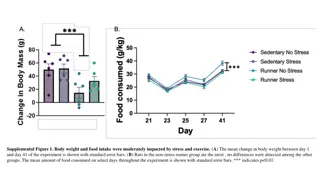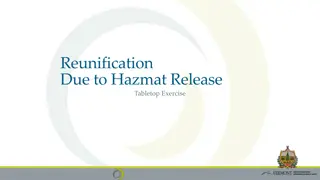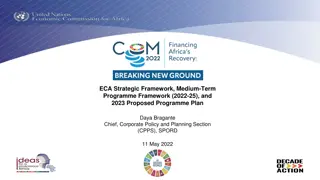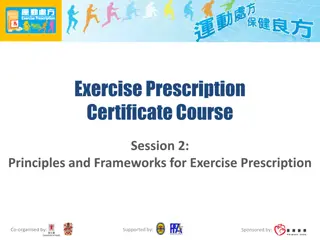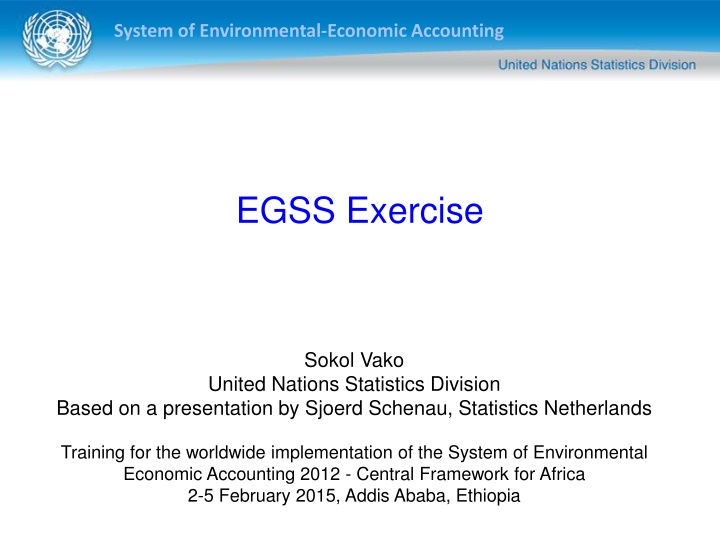
Environmental Economic Accounting: Employment Calculation and Data Analysis
Learn about the System of Environmental-Economic Accounting (SEEA) and how to calculate green employment, a key indicator for policy-making. Explore tables with data on labor input, economic activities, and production figures. Gain insights into the relationship between environmental protection services and government involvement.
Uploaded on | 3 Views
Download Presentation

Please find below an Image/Link to download the presentation.
The content on the website is provided AS IS for your information and personal use only. It may not be sold, licensed, or shared on other websites without obtaining consent from the author. If you encounter any issues during the download, it is possible that the publisher has removed the file from their server.
You are allowed to download the files provided on this website for personal or commercial use, subject to the condition that they are used lawfully. All files are the property of their respective owners.
The content on the website is provided AS IS for your information and personal use only. It may not be sold, licensed, or shared on other websites without obtaining consent from the author.
E N D
Presentation Transcript
System of Environmental-Economic Accounting EGSS Exercise Sokol Vako United Nations Statistics Division Based on a presentation by Sjoerd Schenau, Statistics Netherlands Training for the worldwide implementation of the System of Environmental Economic Accounting 2012 - Central Framework for Africa 2-5 February 2015, Addis Ababa, Ethiopia
System of Environmental-Economic Accounting Calculate green employment Employment in the EGSS is a key indicator that can be used for various policies Calculate based on two of tables with data and some additional information the employment in the EGSS 2
System of Environmental-Economic Accounting 2010 Labour input of employed persons 1 000 years of employment Output mln euros Table 1: SNA data 6719 180 110 30 40 1025466 24563 12290 4398 7875 19317 238809 50777 5876 26899 43039 15431 17899 11353 29590 11002 1506 7021 2475 65960 179064 26876 50490 76211 53960 99968 156632 21703 A-U All economic activities A Agriculture, forestry and fishing of whichAgriculture Fishing Forestry B Mining and quarrying C Manufacturing of which10-12 Manufacture of food and beverages 17 Paper 19 Manufacture of coke and petroleum 20-21 Chemistry and pharmaceuticals 26-27 Elektrical and electron. Industry 28 Manufacture of machinery n.e.c. 29-30 Transport equipment D Electricity and gas supply E Water supply and waste management of which36 Water supply 37-38 Waste and wastewater management 38.3 Recycling F Construction G-I Trade, transport, hotels, catering of whichroad transport J Information and communication K Financial institutions L Renting, buying, selling real estate M-N Business services O-Q Government and care R-U Culture, recreation, other services 7 766 116 23 6 60 59 70 38 25 36 6 23 7 456 1588 187 229 238 63 1010 1787 334 3
System of Environmental-Economic Accounting Table 2: Production data CPC Production million euro Fuel wood 02.20.14 287 17 Paper and paper products 5286 20.14 Biofuels 498 24.5 Steel needed for building windmills 845 27.5 28.11.22 Energy efficient refrigirators (highest standard) Hydraulic turbines and water wheels 934 285 28.11.24 Wind turbines 798 29 Electric cars 374 38.21 Treatment and disposal services of non- hazardous waste 2476 38.22 Treatment and disposal services of hazardous waste 4287 42.22.23 Construction works for power plants 1365 43.29.11 Insulation works 2412 Rail transport Environmental consulting services 8349 4 74.90.13 1639
System of Environmental-Economic Accounting Additional information 50 percent of all specialised environmental protection services relate to waste and waste water management are supplied by the government 15 percent of all energy produced by ISIC 35 is renewable 10 percent of agriculture is organic farming 17 percent of all paper is recycled (i.e. reused in the paper industry) 80 percent of all fuel wood complies with Forest Stewardship Council (FSC) and the Programme for the Endorsement of Forest Certification (PEFC) standards In the ministry for the environment work 1000 people (fte), in the ministry for infrastructure work 1200 people (fte) 5
System of Environmental-Economic Accounting Exercise table Employment in EGSS 1000fte A-U All economic activities A Agriculture, forestry and fishing B Mining and quarrying C Manufacturing D Electricity and gas supply E Water supply and waste management F Construction G-I Trade, transport, hotels, catering J Information and communication K Financial institutions L Renting, buying, selling real estate M-N Business services O-Q Government and care R-U Culture, recreation, other services Total 6






